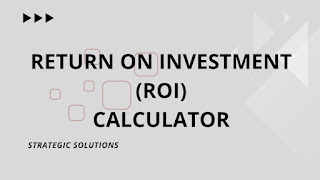Return On Investment (ROI) Calculator - Strategic Solutions
ROI Calculator
Calculate your investment returns and ROI with our easy-to-use ROI Calculator. Simply input your initial investment, the amount returned, and the length of your investment to get detailed results.
Disclaimer
This ROI calculator is designed for informational purposes only and should not be used as a basis for making investment decisions. The accuracy of the results may vary based on the data entered and other factors. Always consult with a qualified financial advisor before making any investment decisions. The use of this calculator is at your own risk. We are not responsible for any losses that may result from using this tool.
FAQs
- What is the ROI Calculator?
- The ROI Calculator is a tool that helps you calculate your investment return on investment (ROI) and annualized ROI based on the amount invested, amount returned, and investment length.
- How do I use the ROI Calculator?
- Simply input the amount invested, amount returned, and investment length (in years and months) and click the "Calculate" button. The tool will automatically calculate the investment gain, ROI, annualized ROI, and total investment length.
- What is ROI?
- ROI stands for Return on Investment. It is a performance metric used to measure the efficiency of an investment. ROI is calculated by dividing the investment gain by the amount invested, and expressing the result as a percentage.
- What is annualized ROI?
- Annualized ROI is a measure of the annual rate of return on an investment over a multi-year period. It takes into account the total investment length and provides a standardized measure of the investment's performance on an annual basis.
- What is the formula for calculating annualized ROI?
- The formula for calculating annualized ROI is: ((1 + ROI)^(1/total investment length) - 1) * 100%
- Is this tool accurate?
- The ROI Calculator provides an estimate of your investment return based on the inputs you provide. However, it is important to note that the actual return on your investment may vary due to various factors such as market fluctuations, inflation, and taxes.
ROI vs. Profit: What's the Difference and Why It Matters
ROI and profit are both important measures of financial performance for businesses. However, they are not interchangeable terms and understanding the differences between them can help you make more informed decisions about your investments and operations.
What is ROI?
ROI, or return on investment, is a measure of the profit or loss generated by an investment relative to its cost. It is calculated by dividing the net profit by the total investment and expressing the result as a percentage.
ROI = (Net Profit / Total Investment) x 100%
ROI can be used to evaluate the efficiency of an investment and compare the profitability of different investment opportunities. A high ROI indicates that the investment is generating a significant return relative to its cost, while a low ROI suggests that the investment may not be worth pursuing.
What is Profit?
Profit is the amount of money a business earns after deducting all of its expenses. It is calculated by subtracting total expenses from total revenue.
Profit = Total Revenue - Total Expenses
Profit is an important measure of financial performance because it represents the amount of money that a business has left over after covering all of its costs. A high profit indicates that the business is generating a significant amount of revenue relative to its expenses, while a low profit suggests that the business may be struggling to generate revenue or control its costs.
Why It Matters
Understanding the differences between ROI and profit is important because they provide different types of information that can be used to make informed decisions about your business. ROI helps you evaluate the efficiency of your investments and decide which opportunities are worth pursuing, while profit helps you assess the overall financial health of your business and identify areas where you can improve.
For example, if you are considering investing in a new marketing campaign, you may calculate the ROI to determine whether the investment is likely to generate a significant return relative to its cost. On the other hand, if you want to evaluate the overall financial performance of your business, you may look at the profit margin to see how much money your business is earning after covering all of its expenses.
Conclusion
ROI and profit are both important measures of financial performance that provide different types of information. While ROI helps you evaluate the efficiency of your investments, profit helps you assess the overall financial health of your business. By understanding the differences between these two measures, you can make more informed decisions about your investments and operations, and improve the profitability and success of your business.






